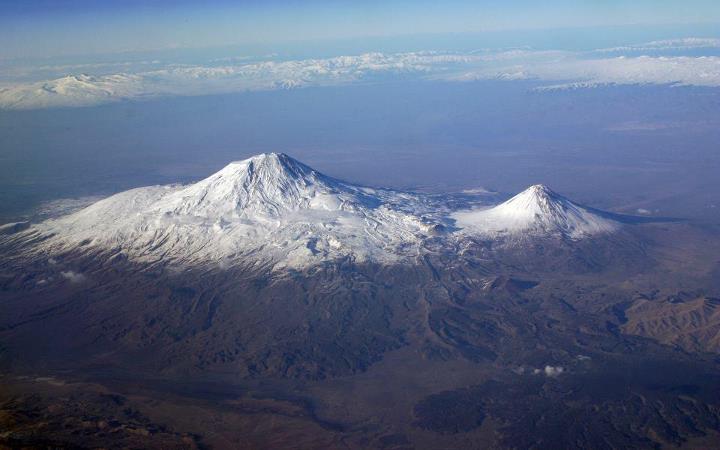Ararat Leran Masin Texekutyun
• • • • Mount Ararat From north to south and east to west, Armenia is simply bound by chains of mountains. The Sevan Mountains are the oldest standing in Armenia, weighing in at 380-1,200 million years old. Volcanoes and massive earthquakes formed the base of the mountainous region, carving mountains, valleys and plateaus on a land that now has an average altitude of 2000 meters (6,560 ft), with less than 10% of the country lying below 1000 meters (3280 ft.). Ararat rises from a flat plain and dominates the skyline of Armenias capital, Yerevan. Since ancient times, Ararat has been revered by the Armenians as their spiritual home and as the home of the gods of the Armenian pantheon.
Ararat Masis Oil Painting, Agopyan Khachig, 5614, $225.00. Ararat Views, Bonus Video. Areve Leran Yedin, Toutjian Sahag, 1646, $10.00. Arevelahay Temker. Ask Rosdami Masin, Rosdam Yev Zohrab, 6417, $25.00. Aslamazian Mariam. Mount Ararat. From north to south and east to west, Armenia is simply bound by chains of mountains. The Sevan Mountains are the oldest standing in Armenia, weighing in at 380-1,200 million years old.
Ararat is the national symbol of Armenia though it is located in Eastern Turkey on the borders of Iran, Armenia (formerly USSR) and Nakhijevan. This volcanic mountain rises 5,165 meters or 16,945 feet high, far above the plains that are at 2,000-3,000 feet high, and is the highest location in the ancient kingdom of Urartu, a region which covered thousands of square miles with hundreds of mountains. The summit of Mt.

Ararat is 5,165 meters above sea level. It is higher than any mountain in the continental United States except for Alaska or in Europe outside the Caucasus. On the north side, Ararat has its roots in the Araks River valley. There it rises from the valley elevation of about 760 meters above sea level. 
In that area the Araks River is the border demarcation between Turkey and Russia. The top of the mountain is only about 30 kilometers from the border. Ararat, an inactive volcano capped year round with ice and snow, reaches 5137 meters. Serdarbulak plateau which is 2687m high divides the area into two peaks: Great Ararat (Buyuk Agri) which is 5137m (16,495 feet) and the Little Ararat (Kucuk Agri) which is 3896m (12,877 feet).
Over the years various groups have explored Ararat in the hopes of finding remains of Noah's Ark. The story of Noah's ark, as it is told in Bible, is a reworking of an earlier Babylonian myth recorded in the Gilgamesh Epic. The hero of the earlier version is one Utnapishtim, the favorite of Ea, the god of wisdom. It seems probable that the Babylonian story was based on an unusually devastating flood in the Euphrates (Firat) River basin, and that the ark in it grounded on the slopes of one of the Zagros mountains.
The biblical word that we read as «Ararat» could as well be read «Urartu»; the text has merely «rrt» and the proper vowels must be supplied. Urartu was the name of a historical kingdom, but the word also meant «a land far away» and «a place in the north». From earliest times, explorers have hunted for the Ark on Mount Ararat. Josephus, in 70 CE, mentioned the existence of the Ark, Dr Nouri, Archdeacon of Babylon and Jerusalem claimed to have located it in 1893; Russian expeditions during the two world wars took photographs (subsequently lost) and a sighting was claimed by an American researcher in 1987. The summit of Ararat was first climbed by Dr Parrot, a German, in 1829. With military permission and a guide, and two overnight camps en route, it present no technical problems.

Several other mountaineering expeditions attempted the route; Freshfield failed in 1868, Denis Hills succeeded in 1955. Mountaineering does not divide people by religion and nationality. There is no border and competition in the mountains.
Main article: Stone tools from 325,000 years ago have been found in Armenia which indicate the presence of early humans at this time. In the 1960s excavations in the Yerevan 1 Cave uncovered evidence of ancient human habitation, including the remains of a 48,000-year-old heart, and a human cranial fragment and tooth of a similar age. [ ] The shows traces of settlement from the era. Archaeological surveys in 2010 and 2011 have resulted in the discovery of the world's earliest known leather shoe (3,500 BC), straw skirt (3,900 BC), and wine-making facility (4,000 BC) at the.